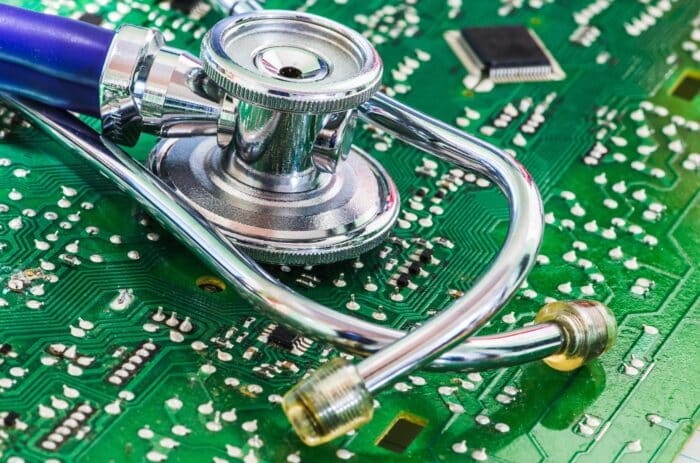Medical Assistants are healthcare workers that work under the supervision of physicians, nurses, and other healthcare professionals and provide them with support services.
They usually work in doctor’s offices, outpatient care centers, and clinics. The duties of medical assistants usually entail both administrative and clinical tasks, ranging from assisting physicians with bedside procedures to scheduling appointments.
Since medical assistants spend the majority of their time assisting physicians and dealing with the medical needs of the patients, they need to have a good knowledge of basic medical terminologies.
Read on to know about the common terminologies you may need to know if you wish to pursue medical assistance as your career.
See more on: What is a Medical Assistant?
Also see: Medical Assistant Career Path
List of Medical Assistant Terminology
When working in healthcare, it is essential to be familiar with the terminology used in your workplace. Understanding what physicians are asking for or how to communicate with insurance companies is crucial.
Additionally, you may need to assist patients by explaining medical terminology in simpler terms.
At times, the healthcare field may feel like learning a new language. However, there’s no need to worry.
Having a grasp of the fundamental concepts will provide a solid foundation, and you can expand your knowledge as you gain more experience.
See: 12 Reasons to Become a Medical Assistant
Common Root Words
- Cephal – Concerning the head
- Derm – Concerning the skin
- Myo – Concerning the muscle
- Osteo – Concerning the bone
- Pulmo – Concerning the lung
- Cardio – Concerning the heart
- Thermo – Indicates temperature
- Arterio – Concerning an artery
- Carcino – Cancerous
- Encephalo – Concerning the brain
- Gastro – Concerning the stomach
Common Prefixes
- Ante – Before
- Endo – Within
- Peri – During
- Post – After
- Trans – Across
- Supra – Above
- Macro – Large
- Micro – Small
- Pseudo – False or fake
Common Suffixes
- uira – The presence of something in the urine
- sclerosis – Hardening
- emia – Blood or referring to a substance in the blood
- desis – Binding together or fixation
- algia – Pain or discomfort
- ology – The study of something
- lysis – Breaking down or destroying
- Itis – Inflammation
- plasty – Surgically repaired
Also see: Can Medical Assistants Draw Blood?
Anatomical Position Terminologies
- Lateral – To one side
- Medial – Nearer to the center
- Anterior – Refers to the front of the body
- Posterior – Refers to the back of the body
- Supine – Describes laying on the back
- Prone – Describes laying on the stomach
- Proximal – Describes something near
- Distal – Describes something further away
- Inferior – Describes something lower than
- Superior – Describes something higher than
- Superficial – Describes something near the surface of the skin
Also see: Medical Assistant Educational Requirements
Common Medicines
- Psychiatry – A field of medicine where patients can get mental health treatment and medication.
- Psychology – Primarily uses talk therapy. Psychologists cannot prescribe medication.
- Cardiology – Medical care for the heart.
- Orthopedics – Medical care for bones and joints.
- Neurology – Medical treatment for the brain and nerves.
- Ophthalmology – Treatment for eyes and vision disorders.
- Pediatrics – Medicine focused on treating children and adolescents.
- Oncology – Medical treatment for cancers.
Common Diseases a Medical Assistant Should Know
- Hypertension – Elevated blood pressure, typically exceeding 120/80.
- Heart failure – Impaired functioning of the heart resulting in inadequate blood circulation throughout the body.
- Cancer – Abnormal proliferation of cells in a specific part of the body.
- Migraines – Intense headaches, often aggravated by loud noises or bright lights.
- Diabetes – A condition in which the body either produces insufficient insulin or is unable to effectively utilize insulin, leading to difficulties in maintaining normal blood sugar levels.
- Kidney failure – Inability of the kidneys to adequately filter toxins from the body, potentially resulting in a cessation of urine production and necessitating dialysis.
- Chronic pain – Persistent pain lasting beyond six months that is not effectively managed.
- Vision loss – Progressive deterioration of eyesight necessitating the use of glasses. It can be caused by factors such as natural aging, cataracts, or other diseases.
- Pneumonia – A respiratory condition characterized by inflammation in the lungs caused by viruses or bacteria.
Body Membrane Terminology
- Mucous membranes – Membranes that line the oral cavity and the digestive system, providing protection and producing mucus to moisten and lubricate the surfaces.
- Serous membranes – Membranes that enclose and protect organs such as the lungs, abdominal organs, and heart. They secrete a serous fluid that reduces friction between the organs and surrounding structures.
- Synovial membranes – Membranes found in joint cavities that facilitate smooth movement between bones by producing synovial fluid, which acts as a lubricant and shock absorber.
- Cutaneous membranes – The skin, which is the body’s largest organ. It functions as a protective barrier and is exposed to the air, making it the driest membrane in the body.
Laboratory Terminology
- Cultures – Laboratory tests performed to identify and analyze bacterial infections present in a sample, such as blood, urine, or tissue.
- Urinalysis – A diagnostic test that examines the physical, chemical, and microscopic properties of urine to detect abnormalities, including the presence of glucose, blood, or signs of infection.
- CBC (Complete Blood Count) – A blood test that provides information about the levels of various blood components, including white blood cells, red blood cells, and platelets. It helps evaluate overall health and detect conditions like infections or anemia.
- Basic metabolic panel – A blood test that measures the levels of electrolytes (such as potassium, magnesium, sodium, and chloride), glucose, and kidney function indicators. It provides information about the body’s metabolic balance and organ function.
- Renal function panel – A set of laboratory tests used to assess kidney function by measuring specific electrolytes, such as creatinine and blood urea nitrogen (BUN), as well as proteins like albumin. These tests help evaluate kidney health and detect any abnormalities.
- Troponin – A laboratory test that measures the levels of troponin proteins in the blood. Elevated troponin levels indicate damage to the heart muscle, often associated with a heart attack or other cardiac conditions.
- Reproductive hormone – A blood test that measures the levels of hormones such as estrogen and testosterone. It is used to evaluate hormonal balance, assess fertility, and diagnose certain reproductive disorders or conditions.
What Medical Instruments Are Called
- Stethoscope – A medical instrument used to listen to sounds produced by the heart, lungs, and abdominal organs. It is also utilized for manually measuring blood pressure.
- Sphygmomanometer – Commonly known as a blood pressure cuff, it is a device used to measure blood pressure.
- Otoscope – An instrument used to examine the inside of a patient’s ear, including the ear canal and eardrum.
- Glucometer – A handheld device that measures blood glucose levels using a small drop of blood, commonly used by individuals with diabetes.
- Catheter – A flexible hollow tube inserted into the body to access or drain fluids from specific areas. Examples include intravenous catheters placed in veins or urinary catheters inserted into the urethra.
- Syringe – A tool consisting of a barrel and a plunger used for drawing up and measuring liquids. Syringes come in various sizes, ranging from as small as 1 ml to as large as 60 ml.
- Sutures – Medical stitches made with strong thread used to close wounds and promote healing.
- Butterfly needle – A small-gauge needle with flexible wings used for drawing blood samples from veins.
- Vacutainer – A specialized blood collection tube used in conjunction with a butterfly needle to collect and store blood samples for laboratory testing.
- Defibrillator – An electronic device used during cardiopulmonary resuscitation (CPR) to deliver an electric shock to the heart, often used to restore normal heart rhythm in cases of cardiac arrest.
- Ultrasound – A non-invasive imaging technique that uses high-frequency sound waves to visualize internal structures and organs in real-time, such as the heart, kidneys, or uterus.
Billing & Insurance Terminology
- HSA – Health savings account: A financial account where individuals can set aside pre-tax money to be used for eligible medical expenses.
- Coverage: The range of medical expenses and services that are included and paid for by an insurance plan.
- Co-payment: A fixed amount that a patient is responsible for paying at the time of receiving medical services, usually determined by the insurance plan.
- Deductible: The amount of money that a patient must pay out of pocket for covered medical services before the insurance coverage begins.
- Out-of-pocket costs: Expenses that are not covered by insurance and must be paid by the patient directly.
- ACO – Accountable Care Organizations: Groups of healthcare providers who voluntarily work together to provide coordinated care to Medicare patients, to improve the quality of care and reduce costs.
- POS – Point of service: Insurance plans that allow patients to receive medical services from providers within their network, but also provide some coverage for services obtained outside of the network, although usually at a higher cost.
- HMO – Health Maintenance Organization: Insurance plans that typically require patients to choose a primary care physician and obtain referrals from that physician to see specialists. These plans focus on preventive care and often have lower out-of-pocket costs.
- PPO – Preferred Provider Organization: Insurance plans that offer more flexibility in choosing healthcare providers. Patients are not required to have a primary care physician or obtain referrals to see specialists, and they can receive partial coverage for services obtained outside of the network.
- MAR – Medication Administration Record: A document used in hospitals to track and record the administration of medications to patients, including the type of medication, dosage, time of administration, and the healthcare professional responsible for administering it.
Other Vocabulary Important to Know for Medical Assistants
- PPE – Personal protective equipment: Equipment, such as gloves, masks, goggles, and gowns, worn by healthcare professionals to protect themselves and prevent the spread of infections or hazardous materials.
- Stat: An abbreviation derived from the Latin word “statim,” meaning immediately or without delay. In a medical context, it indicates that something needs to be done urgently or as quickly as possible.
- BMI – Body mass index: A numerical measurement calculated using a person’s height and weight. It is commonly used to assess whether an individual’s weight falls within a healthy range or indicates underweight, overweight, or obese.
- Arrhythmia: A condition characterized by an irregular or abnormal heart rhythm. It may include a heart beating too fast (tachycardia), too slow (bradycardia), or with an irregular pattern.
- CPR – Cardiopulmonary resuscitation: An emergency procedure performed to manually maintain blood circulation and provide oxygen to a person’s vital organs when their heart has stopped or is not beating effectively. CPR involves chest compressions and rescue breaths to assist in restarting the heart.

Do You Want To Become a Medical Assistant? Check Out Free Medical Assistant Masterclass!
In our masterclass you learn:
- How to be a medical assistant faster…in just 4 months!
- Avoid student debt & driving to classes
- #1 thing employers want from Medical Assistants
- How to stand-apart & get a university certificate for a strong resume
Tips for Learning Medical Assistant Terminology
Learn the basics
Indeed, understanding the root words, prefixes, and suffixes of medical terminology can greatly assist in comprehending and deciphering medical vocabulary.
Building a strong foundation in medical terminology allows you to identify patterns and make connections, making it easier to understand and remember new terms.
It also enables effective communication with healthcare professionals and enhances your ability to navigate the healthcare field.
Study
Tailor your study approach to suit your individual preferences. For visual learners, using flashcards can be an effective method. If you absorb information better through listening, consider exploring resources like YouTube videos or audiobooks to enhance your understanding.
Research the usage of words in practice
Connecting medical terminology to real-life experiences can enhance your retention and understanding of the words. When encountering a challenging word or phrase, try to associate it with a patient story or a memorable experience that involves the term.
By creating meaningful connections, you can better anchor the information in your mind and recall it more effectively. This approach can make the learning process more engaging and relatable, facilitating a deeper understanding of medical terminology.
Read medical news
Engaging in reading medical journals keeps you informed about the latest best practices and advancements in technology, while also providing an opportunity to reinforce your grasp of medical terminology.
See more on Certified Medical Assistant here.
Related Resources:
- How to Become a Medical Assistant
- Medical Assistant Program
- Medical Assistant Skills
- Medical Assistant Interview Questions
- Is Medical Assistant Degree Required?
- Is Medical Assistant School Hard?
- Is Medical Assistant a Good Career?
- Medical Assistant Job Outlook
- Accelerated Medical Assistant Program
- National Certified Medical Assistant NCMA
- Medical Assistant Degree Online 6 Weeks
- Cheapest Medical Assistant Program
- Become a Medical Assistant in 6 weeks
Related Articles
-
How to Be Successful in College in 2022 – 7 Simple Tips to Succeed
-
How Do Scholarships Work? Read This First…Truth is Shocking
-
7 Best College Majors 2024: What Should I Major In?
-
How to Choose a College – 10 Things You Must Consider in 2024
-
Why Go to College? Top 13 Benefits for Adult Students in 2022
-
Top 5 Best Alternatives to Community College for 2024











